Valve Hardware Day 2006 - Multithreaded Edition
by Jarred Walton on November 7, 2006 6:00 AM EST- Posted in
- Trade Shows
Building a Threaded Game Engine
Valve Software researched and experimented with all three multithreading models, and some of the results were promising. The first thing they did was to look at coarse threading, being that it is usually the easiest approach. Like Quake 4 and Call of Duty 2, Valve also has a client-server architecture in the Source engine, so that's where they started. The results can be summarized with the following slide:
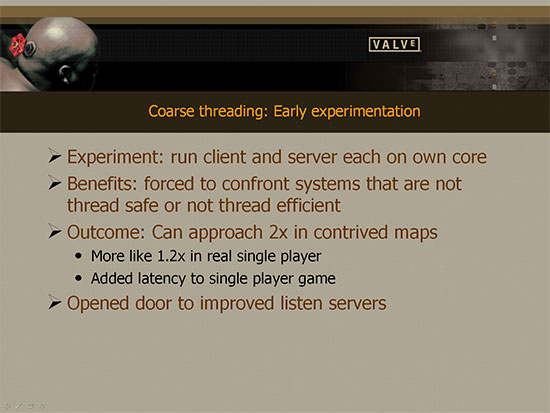
There were benefits to the work that was done, but long-term such an approach is destined to fall short. If you only have a client and a server thread, you are only using two processor cores at most, and even then it is unlikely that you're making full use of both cores. The decision was ultimately reached that the only approach truly worth pursuing as a long-term solution is hybrid threading. It will require the most effort but it will also give the most benefit. As long as you're already rewriting large portions of your engine, the thinking goes, you might as well make sure you do it right so as to avoid doing the same thing again in the near future. The next step is to come up with a threading framework that will allow the developers to accomplish their goals.
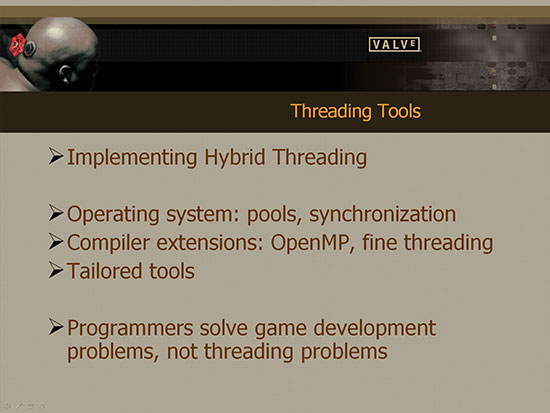
Operating systems and compilers already provide some support for multithreaded programs. In some cases, this support is sufficient, but when it comes to building a real-time gaming engine anything short of a custom threading tool may not provided the desired flexibility. Valve's problems with OS and compiler level threading can be summarized in the following two slides.
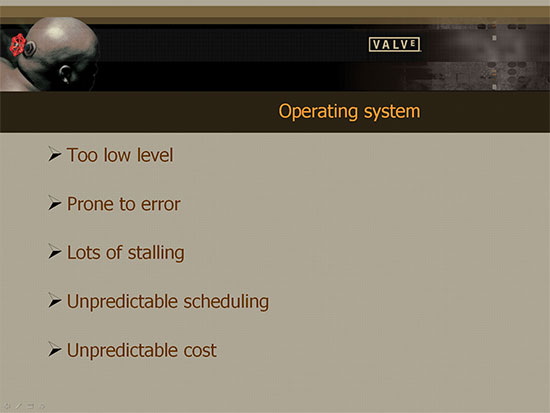
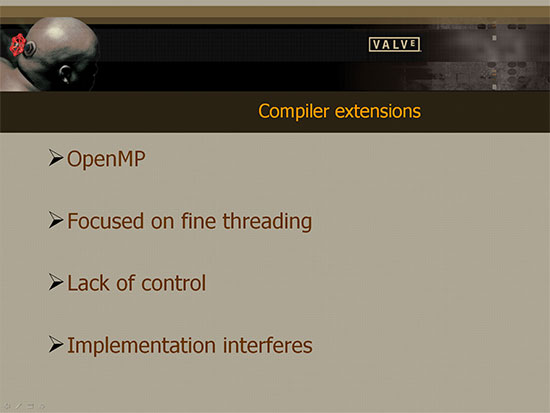
We've already stated several times that making multithreaded programs can be difficult, and the problem is exacerbated when you have many programmers -- some of them junior programmers that have never seen threaded code in their life -- all trying to work together. Valve decided that ultimately what they wanted to create was a threading framework and a set of tools that would allow the programmers and content creators to focus on the important thing, actually creating the games, rather than trying to constantly deal with threading issues. Tom Leonard and a couple other helpers were tasked with creating this toolset, and as you can guess by the existence of this article, their efforts are about to reach fruition.
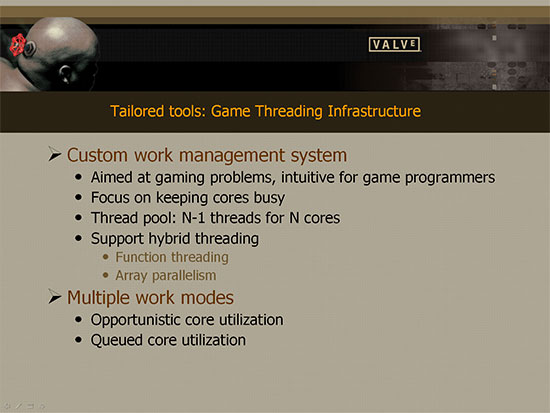
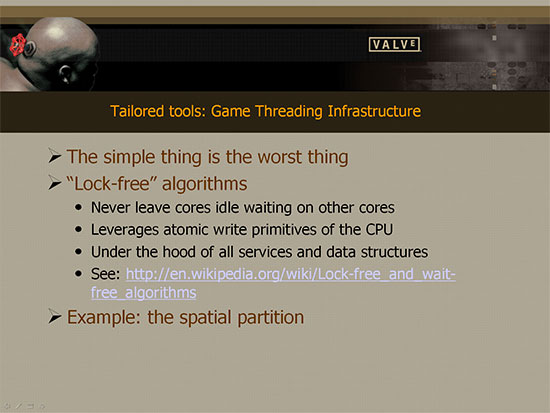
We're not going to try and snowball you with any more information on the low level details at present. Basically, Valve is working hard to provide a toolset that will enable their developers -- as well as mod creators and engine licensees -- to take full advantage of multi-core platforms. They aren't just looking at dual core or even quad core; their goal is to build an engine that is scalable to whatever type of platform users may be running in the future. Of course that doesn't mean they won't be rewriting portions of their engine at some point anyway, but all signs indicate that they should be at the forefront of creating multi-core games and gaming engines.
Valve Software researched and experimented with all three multithreading models, and some of the results were promising. The first thing they did was to look at coarse threading, being that it is usually the easiest approach. Like Quake 4 and Call of Duty 2, Valve also has a client-server architecture in the Source engine, so that's where they started. The results can be summarized with the following slide:

There were benefits to the work that was done, but long-term such an approach is destined to fall short. If you only have a client and a server thread, you are only using two processor cores at most, and even then it is unlikely that you're making full use of both cores. The decision was ultimately reached that the only approach truly worth pursuing as a long-term solution is hybrid threading. It will require the most effort but it will also give the most benefit. As long as you're already rewriting large portions of your engine, the thinking goes, you might as well make sure you do it right so as to avoid doing the same thing again in the near future. The next step is to come up with a threading framework that will allow the developers to accomplish their goals.

Operating systems and compilers already provide some support for multithreaded programs. In some cases, this support is sufficient, but when it comes to building a real-time gaming engine anything short of a custom threading tool may not provided the desired flexibility. Valve's problems with OS and compiler level threading can be summarized in the following two slides.


We've already stated several times that making multithreaded programs can be difficult, and the problem is exacerbated when you have many programmers -- some of them junior programmers that have never seen threaded code in their life -- all trying to work together. Valve decided that ultimately what they wanted to create was a threading framework and a set of tools that would allow the programmers and content creators to focus on the important thing, actually creating the games, rather than trying to constantly deal with threading issues. Tom Leonard and a couple other helpers were tasked with creating this toolset, and as you can guess by the existence of this article, their efforts are about to reach fruition.


We're not going to try and snowball you with any more information on the low level details at present. Basically, Valve is working hard to provide a toolset that will enable their developers -- as well as mod creators and engine licensees -- to take full advantage of multi-core platforms. They aren't just looking at dual core or even quad core; their goal is to build an engine that is scalable to whatever type of platform users may be running in the future. Of course that doesn't mean they won't be rewriting portions of their engine at some point anyway, but all signs indicate that they should be at the forefront of creating multi-core games and gaming engines.










55 Comments
View All Comments
Nighteye2 - Wednesday, November 8, 2006 - link
Ok, so that's how Valve will implement multi-threading. But what about other companies, like Epic? How does the latest Unreal Engine multi-thread?Justin Case - Wednesday, November 8, 2006 - link
Why aren't any high-end AMD CPUs tested? You're testing 2GHz AMD CPUs against 2.6+ GHz Intel CPUs. Doesn't Anandtech have access to faster AMD chips? I know the point of the article is to compare single- and multi-core CPUs, but it seems a bit odd that all the Intel CPUs are top-of-the-line while all AMD CPUs are low end.JarredWalton - Wednesday, November 8, 2006 - link
AnandTech? Yes. Jarred? Not right now. I have a 5000+ AM2, but you can see that performance scaling doesn't change the situation. 1MB AMD chips do perform better than 512K versions, almost equaling a full CPU bin - 2.2GHz Opteron on 939 was nearly equal to the 2.4GHz 3800+ (both OC'ed). A 2.8 GHz FX-62 still isn't going to equal any of the upper Core 2 Duo chips.archcommus - Tuesday, November 7, 2006 - link
It must be a really great feeling for Valve knowing they have the capacity and capability to deliver this new engine to EVERY customer and player of their games as soon as it's ready. What a massive and ugly patch that would be for virtually any other developer.Don't really see how you could hate on Steam nowadays considering things like that. It's really powerful and works really well.
Zanfib - Tuesday, November 7, 2006 - link
While I design software (so not so much programming as GUI design and whatnot), I can remember my University courses dealing with threading, and all the pain threading can bring.I predicted (though I'm sure many could say this and I have no public proof) that Valve would be one of the first to do such work, they are a very forward thinking company with large resources (like Google--they want to work on ANYthing, they can...), a great deal of experience and, (as noted in the article) the content delivery system to support it all.
Great article about a great subject, goes a long way to putting to rest some of the fears myself and others have about just how well multi-core chips will be used (with the exception of Cell, but after reading a lot about Cell's hardware I think it will always be an insanely difficult chip to code for).
Bonesdad - Tuesday, November 7, 2006 - link
mmmmmmmmm, chicken and mashed potatoes....Aquila76 - Tuesday, November 7, 2006 - link
Jarred, I wanted to thank you for explaining in terms simple enough for my extremely non-technical wife to understand why I just bought a dual-core CPU! That was a great progression on it as well, going through the various multi-threading techniques. I am saving that for future reference.archcommus - Tuesday, November 7, 2006 - link
Another excellent article, I am extremely pleased with the depth your articles provide, and somehow, every time I come up with questions while reading, you always seem to answer exactly what I was thinking! It's great to see you can write on a technical level but still think like a common reader so you know how to appeal to them.With regards to Valve, well, I knew they were the best since Half-Life 1 and it still appears to be so. I remember back in the days when we weren't even sure if Half-Life 2 was being developed. Fast forward a few years and Valve is once again revolutionizing the industry. I'm glad HL2 was so popular as to give them the monetary resources to do this kind of development.
Right now I'm still sitting on a single core system with XP Pro and have lots of questions bustling in my head. What will be the sweet spot for Episode 2? Will a quad core really offer substantially better features than a dual core, or a dual core over a single core? Will Episode 2 be fully DX10, and will we need DX10 compliant hardware and Vista by its release? Will the rollout of the multithreaded Source engine affect the performance I already see in HL2 and Episode 1? Will Valve actually end up distributing different versions of the game based on your hardware? I thought that would not be necessary due to the fact that their engine is specifically designed to work for ANY number of cores, so that takes care of that automatically. Will having one core versus four make big graphical differences or only differences in AI and physics?
Like you said yourself, more questions than answers at this point!
archcommus - Tuesday, November 7, 2006 - link
One last question I forgot to put in. Say it was somehow possible to build a 10 or 15 GHz single core CPU with reasonable heat output. Would this be better than the multi-core direction we are moving towards today? In other words, are we only moving to mult-core because we CAN'T increase clock speeds further, or is this the preferred direction even if we could.saratoga - Tuesday, November 7, 2006 - link
You got it.A higher clock speed processor would be better, assuming performance scaled well enough anyway. Parallel hardware is less general then serial hardware at increasing performance because it requires parallelism to be present in the workload. If the work is highly serial, then adding parallelism to the hardware does nothing at all. Conversely, even if the workload is highly parallel, doubling serial performance still doubles performance. Doubleing the width of a unit could double the performance of that unit for certain workloads, while doing nothing at all for others. In general, if you can accelerate the entire system equally, doubling serial performance will always double program speed, regardless of the program.
Thats the theory anyway. Practice says you can only make certain parts faster. So you might get away with doubling clock speed, but probably not halving memory latency, so your serial performance doesn't scale like you'd hope. Not to mention increasing serial performance is extremely expensive compared to parallel performance. But if it were possible, no one would ever bother with parallelism. Its a huge pain in the ass from a software perspective, and its becoming big now mostly because we're starting to run out of tricks to increase serial performance.